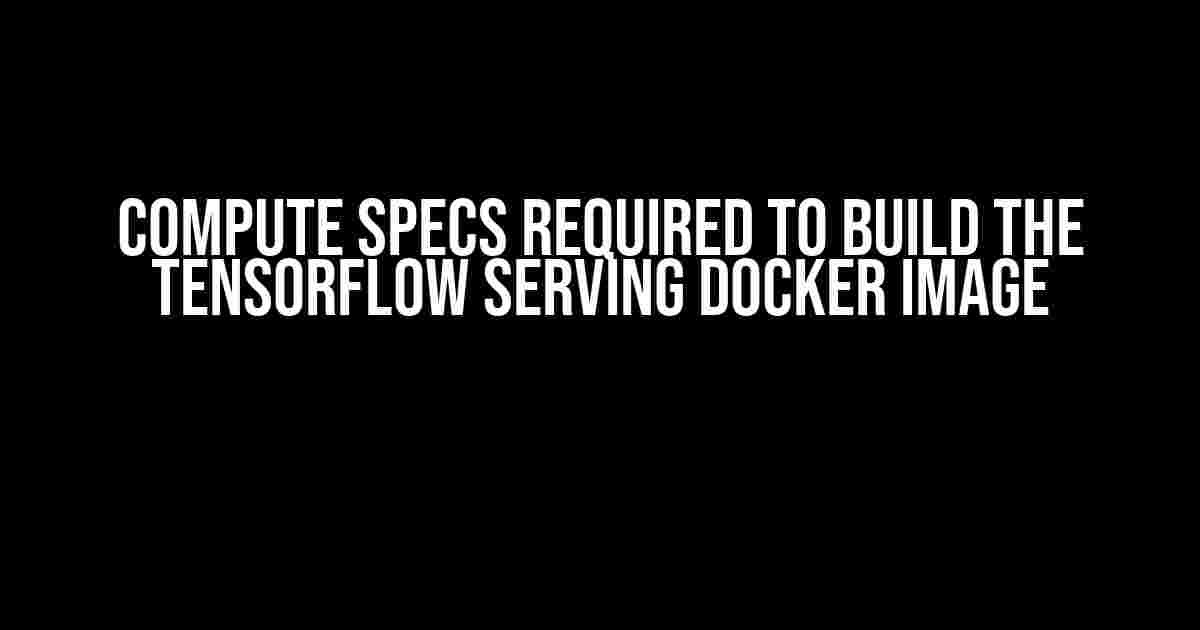Are you ready to unleash the power of TensorFlow Serving and deploy machine learning models at scale? Before we dive into the nitty-gritty of building a TensorFlow Serving Docker image, it’s essential to ensure your computing environment meets the required specifications. In this article, we’ll explore the compute specs necessary to build a TensorFlow Serving Docker image, providing you with a comprehensive guide to get started.
Why Compute Specs Matter
Building a TensorFlow Serving Docker image requires significant computational resources, especially when working with large models and datasets. Insufficient compute specs can lead to slow build times, model inference delays, and even failed deployments. By understanding the required compute specs, you can optimize your environment for efficient TensorFlow Serving deployments.
Minimum Requirements
To build a TensorFlow Serving Docker image, you’ll need to meet the following minimum compute specs:
- CPU:** 2+ CPU cores (Intel Core i5 or AMD equivalent)
- Memory:** 8+ GB RAM (16+ GB recommended for larger models)
- Storage:** 50+ GB available disk space (SSD recommended for faster build times)
- Operating System:** 64-bit Linux distribution (Ubuntu, CentOS, or equivalent)
These minimum requirements will allow you to build a basic TensorFlow Serving Docker image. However, for more complex models and larger datasets, you may need to upgrade your compute specs.
Recommended Compute Specs
To unlock the full potential of TensorFlow Serving, consider upgrading to the following recommended compute specs:
- CPU:** 4+ CPU cores (Intel Core i7 or AMD equivalent)
- Memory:** 16+ GB RAM (32+ GB recommended for larger models)
- Storage:** 100+ GB available disk space (high-performance SSD recommended)
- GPU:** NVIDIA GPU with 4+ GB VRAM (optional, but recommended for accelerated model inference)
With these recommended compute specs, you’ll be able to build and deploy more complex models, handle larger datasets, and take advantage of GPU acceleration for faster model inference.
GPU Acceleration
If you plan to use TensorFlow Serving for model inference, consider investing in a GPU with 4+ GB VRAM. This will enable you to take advantage of GPU acceleration, significantly reducing model inference times. Popular options include:
- NVIDIA Tesla V100
- NVIDIA Tesla P40
- NVIDIA GeForce RTX 3080
Keep in mind that GPU acceleration requires a compatible NVIDIA GPU and the TensorFlow GPU runtime.
Building the TensorFlow Serving Docker Image
Now that you’ve ensured your compute specs meet the requirements, let’s dive into building the TensorFlow Serving Docker image.
Install Docker
First, install Docker on your system if you haven’t already:
sudo apt-get update
sudo apt-get install docker.io
Start the Docker service and enable it to start automatically on boot:
sudo systemctl start docker
sudo systemctl enable docker
Clone the TensorFlow Serving Repository
Clone the TensorFlow Serving repository using Git:
git clone https://github.com/tensorflow/serving.git
Build the TensorFlow Serving Docker Image
Navigate to the cloned repository and build the TensorFlow Serving Docker image:
cd serving
docker build -t tensorflow/serving .
This command builds the TensorFlow Serving Docker image using the default settings. You can customize the build process by specifying additional flags or environment variables.
Troubleshooting Common Issues
During the build process, you may encounter some common issues. Here are some troubleshooting tips:
Insufficient Memory
If you encounter memory-related errors during the build process, consider increasing the amount of available RAM or swapping to a system with more memory.
Slow Build Times
If the build process is taking too long, consider upgrading your storage to a high-performance SSD or using a faster storage option.
GPU Acceleration Issues
If you’re experiencing issues with GPU acceleration, ensure you have a compatible NVIDIA GPU and the TensorFlow GPU runtime installed.
Conclusion
Building a TensorFlow Serving Docker image requires careful consideration of compute specs. By meeting the minimum requirements and upgrading to recommended specs, you’ll be able to deploy machine learning models efficiently and effectively. Remember to troubleshoot common issues and optimize your environment for the best results.
| Compute Spec | Minimum Requirement | Recommended Spec |
|---|---|---|
| CPU | 2+ CPU cores | 4+ CPU cores |
| Memory | 8+ GB RAM | 16+ GB RAM |
| Storage | 50+ GB available disk space | 100+ GB available disk space |
| GPU | N/A | NVIDIA GPU with 4+ GB VRAM |
With this comprehensive guide, you’re now ready to build and deploy your TensorFlow Serving Docker image. Happy building!
Frequently Asked Questions
Get ready to dive into the world of TensorFlow Serving and Docker images! Here are the top 5 questions and answers to help you build your dream image.
What are the minimum compute specs required to build a TensorFlow Serving Docker image?
The minimum compute specs required to build a TensorFlow Serving Docker image are 2 CPU cores, 4 GB of RAM, and 10 GB of disk space. However, it’s highly recommended to have more powerful machines with at least 4 CPU cores, 16 GB of RAM, and 50 GB of disk space for faster builds and better performance.
Can I use a lower version of Docker to build the TensorFlow Serving image?
No, it’s recommended to use Docker 18.09 or later to build the TensorFlow Serving image. This is because TensorFlow Serving requires certain features and dependencies that are only available in newer versions of Docker.
Do I need to install any additional packages or dependencies to build the TensorFlow Serving image?
Yes, you may need to install additional packages or dependencies such as CUDA, cuDNN, and NVIDIA Docker runtime depending on your specific use case and hardware configuration. Make sure to check the official TensorFlow Serving documentation for the most up-to-date requirements.
How long does it take to build a TensorFlow Serving Docker image?
The build time for a TensorFlow Serving Docker image can vary greatly depending on the compute specs, network speed, and the complexity of your model. On average, it can take anywhere from 10 minutes to several hours to build the image.
Can I use a ARM-based machine to build the TensorFlow Serving image?
Currently, TensorFlow Serving only supports x86-64 architectures, which means you’ll need to use an Intel or AMD-based machine to build the image. However, there are ongoing efforts to add support for ARM-based architectures in the future.


